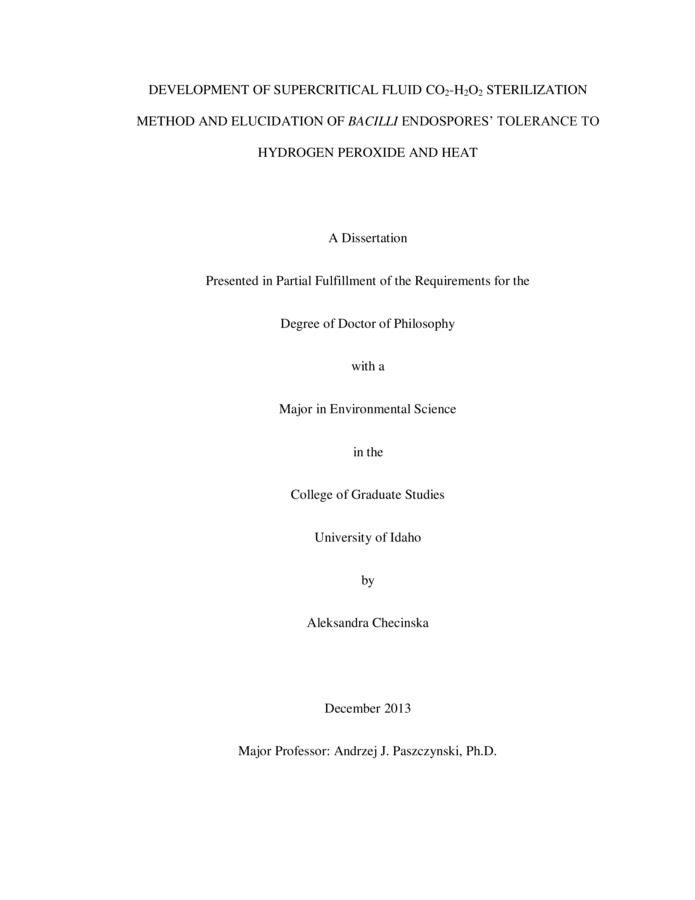Please note: this collection is no longer updated. Visit our Theses and Dissertations Collection in VERSO for all U of I ETD since 2012.
ETD PDF
Supercritical Fluid Carbon Dioxide and Hydrogen Peroxide Sterilization Method and Elucidation of Bacilli Endospores' Tolerance to Hydrogen Peroxide and Heat
Citation
Checinska, Aleksandra. (2013). Supercritical Fluid Carbon Dioxide and Hydrogen Peroxide Sterilization Method and Elucidation of Bacilli Endospores' Tolerance to Hydrogen Peroxide and Heat. Theses and Dissertations Collection, University of Idaho Library Digital Collections. https://www.lib.uidaho.edu/digital/etd/items/etd_398.html
- Title:
- Supercritical Fluid Carbon Dioxide and Hydrogen Peroxide Sterilization Method and Elucidation of Bacilli Endospores' Tolerance to Hydrogen Peroxide and Heat
- Author:
- Checinska, Aleksandra
- Date:
- 2013
- Keywords:
- Bacillus Chaperones Hydrogen Peroxide Manganese Catalase Spores Supercritical Fluid Carbon Dioxide Microbiology Biochemistry Environmental science
- Program:
- Environmental Science
- Abstract:
- When growth conditions become unfavorable, <i>Bacilli</i> species produce a spore that can survive stringent environmental conditions such as heat, UV and ionizing radiation, and chemical treatments. <i>B. pumilus</i> SAFR-032 was consistently isolated from a spacecraft assembly facility at the Jet Propulsion Laboratory in Pasadena, CA. The endospores of SAFR-032 showed elevated resistance to 5% hydrogen peroxide. Since hydrogen peroxide is being considered as a spacecraft sterilization agent for future space exploration and life detection missions, the resistance of the<i> Bacilli</i> spores affects the bioload requirements. The goals of this research involved developing a new supercritical fluid carbon dioxide sterilization method and elucidating several aspects of SAFR-032 spores' resistance to hydrogen peroxide and heat. The optimal conditions to inactivate 10<super>6</super> spores of SAFR-032 were 80 atm at 50°C during a 30-minute treatment time. Moreover, the sterilization method inactivated biofilms of SAFR-032, <i>P. aeruginosa</i>, <i>K. pneumoniae</i>, <i>A. baylyi</i>, <i>Salmonella spp</i>. and spores of <i>A. nidulans</i> and <i>A. fumigatus</i> as well. Two manganese catalases, YjqC and BPUM_1305, were identified in SAFR-032 spore's coat. In the presence of hydroxylamine, a manganese catalase inhibitor, the viability of spores after hydrogen peroxide treatment dramatically decreased. The catalases contribute to the protection against hydrogen peroxide not only by decomposition of this compound, but also by formation of a diffusion barrier consisting of oxygen vesicles retained on spore's surfaces. The barrier contributes to protection by limiting diffusion of peroxide to the spore interior. A proteomic study of SAFR-032 spores obtained at 26°C and 42°C showed an elevated amount of small acid soluble proteins and chaperones: GroEL, DnaK and Tig in spores obtained from culture grown at 42°C. The protein levels of both S and L ribosomal subunits did not change except for the following individuals: S1, 8, 10, 16, 19 and L5, 7/12, 22, 25, 19, 35 that showed increased concentration in spores obtained at 42°C. The elevated amount of these proteins was correlated with the higher resistance of SAFR-032 spores to heat. The presented studies provide novel information on spore resistance that will lead to a more profound understanding of their physiology and the development of novel more effective sterilization methods.
- Description:
- Thesis (Ph. D., Environmental Science)--University of Idaho, December 2013
- Major Professor:
- Andrzej Paszczynski
- Type:
- Text
- Format:
- application/pdf
Rights
- Rights:
- In Copyright - Educational Use Permitted. For more information, please contact University of Idaho Library Special Collections and Archives Department at libspec@uidaho.edu.
- Standardized Rights:
- http://rightsstatements.org/vocab/InC-EDU/1.0/

